It is best not to get caught in a storm in the mountains, but when/if this happens, it is good to know what to do. Here I share my experience from decades of mountaineering.
Unless you go hiking in exotic places like Sahara or Atacama Desert, it is certain that sooner or later you will find yourself caught in a storm.
When you are in the mountains and the weather is unstable, keep an eye on how the weather changes. If you are caught in a storm, do not panic.
Try to get off exposed places as soon as possible, to avoid being hit by lighting, and try to find a shelter to protect you from the rain. But keep reading for more details.
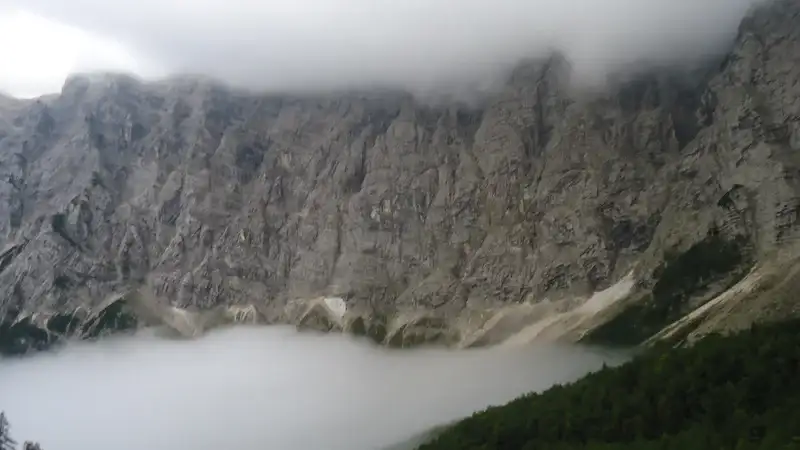
So what to do if you are caught in a storm in the mountains?
I have seen some really strange advises of the type ‘crouch down with feet together and arms around knees, and with head on knees…and stay calm and wait until the next clear interval to continue your hike.’
Oh yes, such experts also suggest that you put your backpack underneath you and this is supposed to give you an extra layer of protection if lighting strikes the ground nearby. Apparently electricity would not get to you, the wet pack is supposed to insulate you from the ground.
Now, think about millions of volts that you can have in a lighting bolt and tens of thousands of amperes of electric currents. Compare this with 120-220 volts that we have in the house, and you will realize what you have to deal with.
In fact, if you crouch down as suggested, you only increase the chance for being electrocuted from the ground. You have a better chance for survival if only feet in boots are in contact with the ground.
So imagine, you are in the storm somewhere high in the mountains, and you wait on your knees till it passes, while your back is exposed to the cold rain and it is getting soaked to the skin. In other words, you would increase your chances to die from hypothermia, and your pack would not protect you from the lighting in any case.
I understand what the author wanted to say, but I cannot imagine any living person doing something ridiculous like this. What is the point of giving advises that are counterintuitive and against our nature and that would not be followed by anybody?
Be prepared for weather changes
Recently, I was caught in a storm on Piz Boe in the Dolomites, Italian Alps. I knew the rain was coming, but I have had a full waterproof layer (pants and a jacket), plus a waterproof poncho. So I was descending calmly from the Forcella Pordoi hut.
This was a thunderstorm with lighting, but there were higher peaks around, so I did not feel I was particularly in danger. Even if I was, I would not wait on my knees till the lighting was over. Namely, you cannot predict when it will strike, and waiting for it to happen just makes no sense. So be logical and keep going.
Now, the sad reality is that such “waterproof” stuff is rarely fully waterproof, I mean pants and rain jackets. They will always leak somewhere. But with all of them together plus my Salomon boots, I was fine in that 90 minutes walk towards Passo Pordoi where I left my car.
Keep an eye on weather changes
But as mentioned above, it is important to keep an eye on the clouds. Weather is unpredictable in the mountains and I would say that mountains make their own weather.
The picture below shows how a storm was preparing as I was descending from Monte Confinale in the Italian Alps. In 20 minutes or so later, I was in a storm with the rain and snow combined.
Did I rush? Not at all, I accepted the weather as it was and enjoyed the day, I was even singing as I was descending in the rain and snow.
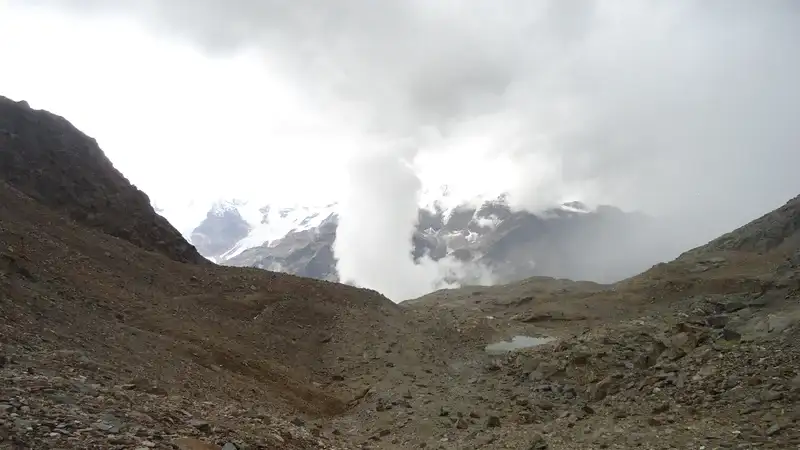
It may sound strange, but some of my best moments in the mountains are those where I had experienced the nature in its full might.
Try to find and locate shelters of any kind
I have been in more storms than I can remember, but this has never been so because I wanted it. Sometimes you do not have a choice, the weather in the mountains can change in minutes.
But here are a few tips that you might find useful.
• In decades of mountaineering, it became a subconscious thing to me that I always try to notice any natural shelter that is somewhere around the route.
This can be a small cave, an overhanging rock with space underneath it to protect me from the rain, a tree (but not an exposed and lonely one), etc.
Even an abandoned hunters outhouse may be good, see the picture below. This is from Zermatt area in the Swiss Alps, my shelter for a day in the rain, even very convenient if the nature calls…
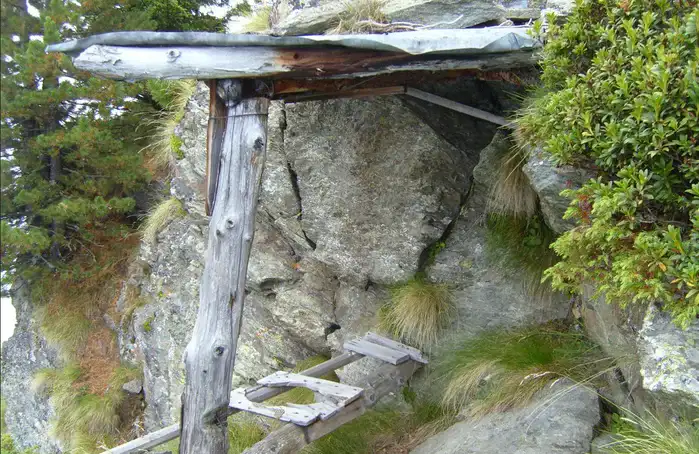
• If you realize that the storm is coming, try to get to such a shelter in time. But do not rush, and here is why.
I was in the Slovenian Alps, it started raining and I was going up a steep section. So I was sweating and was wet even without the rain.
I noticed a small cave off the route, so I climbed there and stayed for almost two hours. I was sweaty, and in time my body was cooling as my underwear clothing was drying on me. So I developed a mild state of hypothermia and I was trembling.
But those were beautiful moments, the top picture above shows how it was when I had some views. The picture shows one of the rock walls above Vrata valley near Triglav. The view is from a point below Dovska Vratca pass.
In some other occasion, on my tour to Fluela Wisshorn in Swiss Alps, I found shelter in front of something that looked like a military installation in the rock, possibly from WWI, shown in the picture:
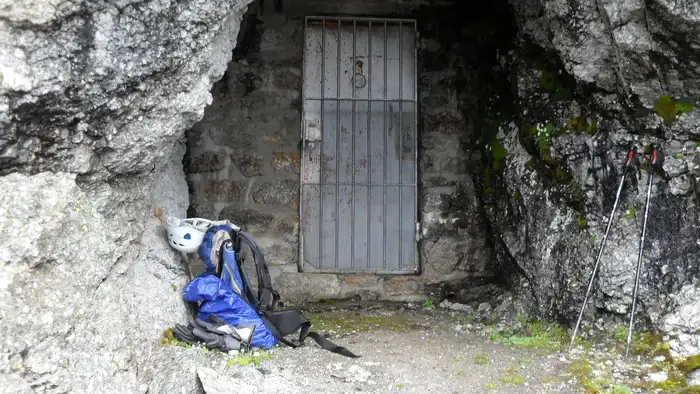
Be reasonable and logical, you cannot compete with the Nature
You should know when it is time to give up. It is a very bad decision to try to outrun the storm in order to get to the summit.
See the picture below, this is from my unsuccessful tour to Monte Cevedale in the Italian Alps from the south side. After many hours of walk, this was the moment I realized that it was time to go back. I was in the rain on a ridge where progress was very slow and the summit was still far away.
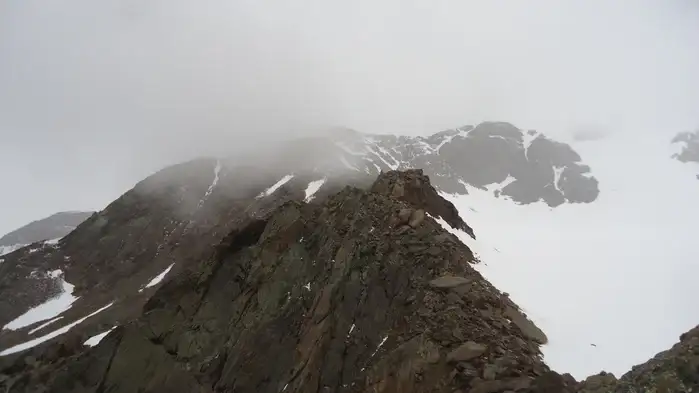
But wait, I did not call it a day. After giving up from my summit tour, I made a round tour and visited a few lakes and this all in the rain. See one of the lakes from that tour below, it was raining heavily when I was taking this photo.
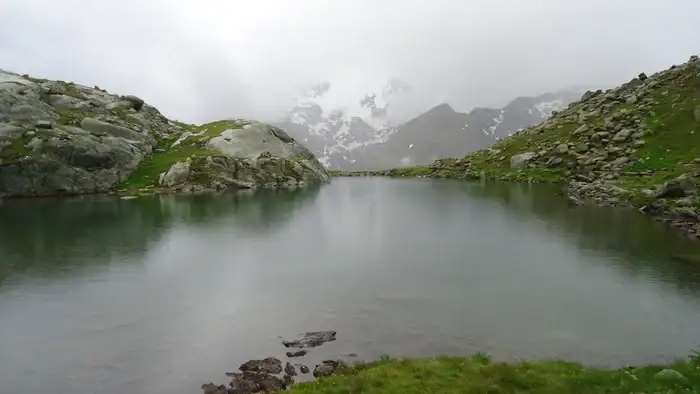
It was a great day after all. But you realize why this was so, I was prepared and I was able to walk in the rain. And I knew what my limits were for that day.
I was not there to fight the nature, I was there to enjoy it and to appreciate it as it was. Mountains do not care about us, they are cold and unhospitable. But they are beautiful and we have to accept them as they are, no matter if it rains or not.
Know what to expect, be informed about the route
But see also this episode. We were on our tour to Monte Breva in the Livigno Area, Italy, and we had rain.
So we changed the direction and found shelter in a beautiful refuge at Lago del Monte, see the picture below. This is a stone building without a guardian, always open.
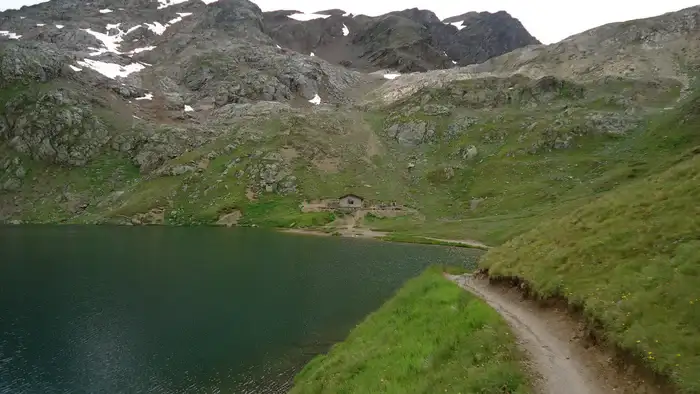
We spent several hours there, made a fire in the stove, had a coffee, and when the weather changed we continued and climbed the summit.
The point of this particular story is that we knew that the refuge was there. So we made a detour and used the shelter. Yet in the end, we managed to get to the summit dry and refreshed.
Is it safe to go hiking in the rain?
This question implies that you start your hiking tour when it is raining. So is it safe? The answer can be both yes and no.
Of course you can make a hike on a mild terrain even when it is raining. In fact, I love to do this. Walking in the rain is refreshing and it relaxes me a lot.
My experience is that a rain poncho is a much better option than the usual rain jacket. It offers far more protection, and you can use it if it is not very windy and you do not have any scramble on the route. You put it over your pack as well.
But how about the answer no?
- I would say this is mainly about getting to exposed places where you may get hit by lighting. So definitely avoid such places.
- Also, if the rain is combined with a strong wind, make sure you are not in a forest where you could have pieces of broken branches landing on you below.
- Make sure you know the terrain so that there cannot be sudden flooding. So do not walk on a dry river bed or something similar.
- Avoid places with possible lose rocks above you, that can be destabilized by the rain.
Final thoughts
In summary, if you are caught in a storm in the mountains, then this is a bad lack or your poor planning. But be reasonable if this happens and do not follow ridiculous advices to wait on your knees till the storm is over.
So get down from sharp and exposed places as quickly as possible, and if this is not an option, look for a shelter and wait till the storm is over.
Oh yes, I have even seen somebody suggesting to avoid such shelters because of danger of lighting and its electricity that will spread around and it may kill you. But hey, let’s be serious. What is the alternative?
For more texts of this type please check in the category FAQs here in the site.
Subscribe to my weakly newsletter and stay informed, the subscription form is given below. Thank you for reading and have a nice day.
Leave a Reply